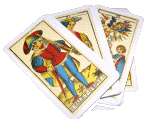
Bohemian Gothic Tarot
IV THE EMPEROR
Lighter or more conventional meanings
Logic and rationale * A respect for tradition and strong leadership * Ingenuity, particularly with mechanical and artificial machines and devices * Fair and reasoned authority * Rules and order based on rational rather than emotional judgements.Darker, shadow or more hidden meanings
Authoritarian rule that's ruthless and dictatorial * Fanaticism, megalomania * Imperialism * Desire to expand a power base whatever it takes * A belief that "the end justifies the means" * Certainty that "might is right" * Autocratic person who tolerates no disagreement * Cruelty under the guise of strength.The Emperor is a card that often arouses a degree of antagonism. The card stands for the kind of authority, power and strict rationalism that we usually characterise as male and that, nowadays, we often associate with arrogance, dominance and a lack of fellow-feeling. However, while this can indeed apply in some readings, in general this is a harsh way to view The Emperor. Essentially, the card is a partner to The Empress and between them, they make a balanced whole. After all, what is logic without emotion, or emotion without logic? The Emperor and Empress need one another, and these cards, in traditional tarot, only become "problematic" when they are expressed in an extreme or unbalanced way.
Having said this, the image here makes this one of the most graphically disturbing cards in The Bohemian Gothic deck. The richly dressed and much-be-medalled central figure is surrounded by human bones displayed, it seems, as trophies. He stands proudly gazing at the morbid wreaths hanging from the ceiling, while gesturing with one hand at the heap of skulls in front of him. All of these are human except for one antelope skull, that stands out startlingly. This may be taken in several ways; as a sign that the people, like the antelope, were hunted down, as a nod to the traditional ram skull that is one of the RWS Emperor card's symbols and also, intriguingly, as a reference to the antelope that Shiva, God of Destruction, carries as an attribute.
This is a man who appears full of egotism and triumph, utterly sure of his own opinions and importance. He has few redeeming features. Certainly he is not likeable; there is a smugness and self-importance about him that would be unattractive even without the grim scene around him. To some, his power and success might seem admirable, but here we see, quite explicitly, the ruthlessness and calculation that's behind it. This Emperor is a warning that when lack of emotion become cruelty, and logic and rationale are used only to crush others, then the ruler becomes a destructive dictator and only evil can result.
In The Bohemian Gothic Tarot both the Emperor and Empress are rich, imperious, rather frightening characters who seem delighted, rather than horrified, by death. They are both unafraid to look it in the eye (or should that be the eye socket?) and are almost gleeful about it. But whereas the Empress simply embraces death as part of life and all thing living, the Emperor feels compelled to arrange and order it. An aim which is, ultimately unattainable. We know, as we look at this card, that the Emperor's strange realm will crumble over time and that, in the end, though he can command, and even crush, people, he will have no dominion over death.
Some further ways to consider this card
What is this Emperor's story? Who were the people whose bones we see? How did the antelope skull come to be displayed among them?Moliere's Don Juan, Goethe's Faust, Byron's Manfred, Mathurin's Melmoth - great allegorical figures drawn by the greatest men of genius in Europe, to which Mozart's harmonies, perhaps, do no more justice than Rossini's lyre. Terrible allegorical figures that shall endure as long as the principle of evil existing in the heart of man shall produce a few copies from century to century.
- Honore de Balzac, The Elixir of Life.









